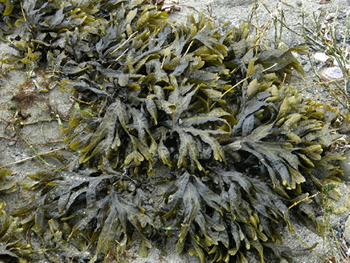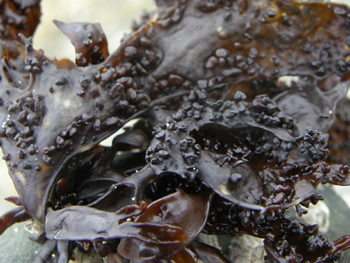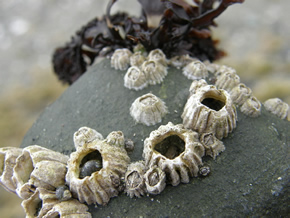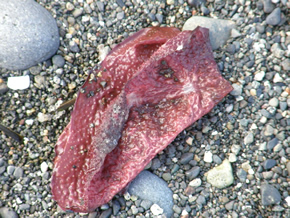In the Paths of Tides. |
|
The rolling in and out of the tides, with the wind and rain of the winter storms, many coast lines are dotted with the remains of thousands of years of buffeting by so many of these forces. |
|
| |
In turn, these mammoth monolith structures attract a mutitude of species from the great selection that nature offers.
|
| |
|
| |
On the larger or higher islands, a few trees find the space to develop a few roots and although they may never attain great heights, they add a little beauty to the bare rock. These in turn may provide a safe haven for a number of birds, but the rock itself is the main attraction for so many more birds that find these spots relatively safe from predators. |
| |
| |
| |
As the tide recedes during the summer season of low tides, we are able to observe a few of the animals that would be otherwise safely hidden from view in rocky crevices and hollows. |
| |
|
| |
As we leave the water with the Pigeon Guillemots putting on a show, we go exploring amongst the rocks. |
|
|
| |
The common starfish, Asterias rubens, comes in many colors these shown here are but two of them. They are related to sea urchins as they also have tube feet. |
| |
|
| |
The starfish however, does not have a rigid skeleton but a tough thick skin that protects it. They can withstand each others company and can be found in huge numbers. They feed on mussels and clams |
| |
|
| |
The Green Anemone, Anthopleura xanthogrammica, lives in the tide pools along exposed shores. There may be many close together but are not aggressive towards each other. The tentacles are poisonous which it uses to paralyze its food that includes mussels, sea urchins and small fish and crabs. |
| |
|
| |
There are numerous species of barnacles and here we have the Giant Acorn Barnacle, Balanus nubilus, found on the low tide mark of open coasts. It adheres to rocks and hard surfaces. They grow in bunches and also on top of each other forming huge masses that are frequently broken off in storms. |
| |
|
| |
Another of the barnacles is the much smaller Acorn Barnacle, Balanus glandula. As an adult they live in huge colonies and attach themselves to any hard surface like rocks, pebbles pillings and boats. The name of course comes from the shape of the hard calcerous plates that protect its body. Like all barnacles, the acorn barnacle feeds on microscopic plants and animals. |
|
|
| |
| With the summer month’s low tides, we are able to explore areas that are often inaccessible. One of these areas is the green algae, the home of so many creatures seeking protection from so many predators. Here we invade the privacy of the Green Shore Crab, Hemigrapsus oregonensus. |
| |
|
| |
| This is definitely a slimy type of habitat as we see one of the crabs emerging on the left. The photograph on the left shows where it gets the common name from, Green Shore Crab. It is an aggressive resident of this inter tidal zone |
| |
|
| |
Three Rib Kelp, Cymathere triplicata , has a discoid hold fast instead of the finger like haptera. It is an annual brown seaweed with folds running the full length of the blade which can reach 12 feet in length. It is found on low intertidal rocky shores. |
| |
|
| |
Bull kelp, Nereocystis luetkeana. grows in underwater forests in shallow oceans and offers a secure home to many sea creatures or food for others. Sea otters love to use these thick kelp beds. The plant is secured by an enormous holdfast. A bulbous float is shown on the right that keeps the fronds afloat and at low tide can be seen bobbing about in the water. |
| |
 |
|
 |
Rockweed, Fucus distichus, is very common in the middle intertidal zone. A shoot grows from a holdfast and repeatedly divides. It produces slimy mucus to help prevent it from drying out when exposed.
|
|
|
| |
Most of the sea life is only observed on the rocks and shore at low tide or washed up onto the beaches after a storm. One of these casualties is this Sunflower Star, Pycnopodia helianthoides. This is the largest sea star in the world and worth looking for in the tide pools as it may be stranded as it forages for food. When young they have 6 arms but as they age they can have more than 20. They are rapid movers compared with the other stars and cause panic amongst other animals when it enters any tide pool. Sea urchins are a favorite food but everything is eaten even other stars if they do not depart quickly. |
| |
 |
|
Sea Lettuce, Ulva species, is edible and grows in the low to mid interidal one. It occurs on the west coast from Alaska down to Chile. Its main habitat is on rocks in shallow areas that are protected from strong waves and the sun. It is also common in esturies where it ataches itself to eelgrass, it can also grow on pilings and boat docks if conditions are favourable.
|
|
|
Another intriquing name for a seaweed is Nail Brush, Endocladia muricata, it is very common an appears dark red to purple and sometimes brown. it favors the very high reaches of the shore, clinging to the rocks with the Acorn Barnicles. Many small creatures crawl inside the tangles of this alga yo shelter from predators and the elements. |
|
 |
|
| |
|
| |
The bright reds of Turkish towel, Chondracanthus exasperatus, are easily spotted when washed ashore. |
| |
As it ages it loses this bright and intense color and turns dark purple to nearly black. Then in the winter the blades die off and are a frequent addition the other seaweeds washed up on the shores after the storms. The holdfast however waits for spring to start new growth. |
|
 |
|
| |
|
| |
| The California Mussel, Mytilus californiensis, is quite unmistakable and it thrives in vast number huddled together in the pounding surf. They may layer themselves on the tops of others and this in turn can cause them problems. The mussels at the bottom have a hard time holding into the rocks in stormy conditions with all the extra weight. Large waves can then tear out masses of these creatures. When this happens, the bare rock is quickly re colonized |
| |
|
| |
We end this brief tour of the tides and marine life with one of those very popular sea urchins, the Eccentric Sand Dollar, Dendraster excentricus. These have been hand painted by artists and collected by children. The patterns on these creatures are rather unique and do appear to have been etched indeed by artists. Normally these creatures are covered with spines and when they die these spines are washed away revealing the shell as we know it.
|
| |





























